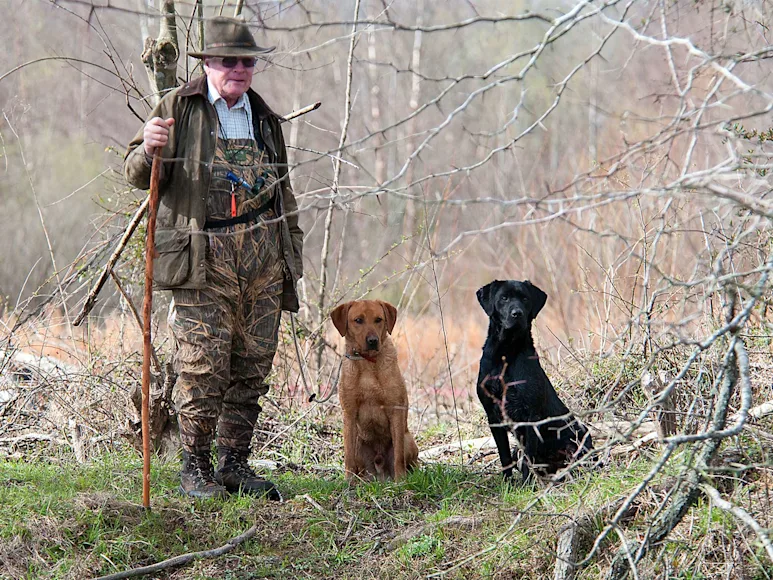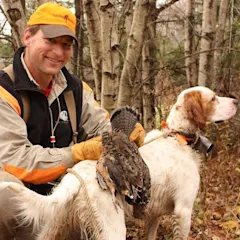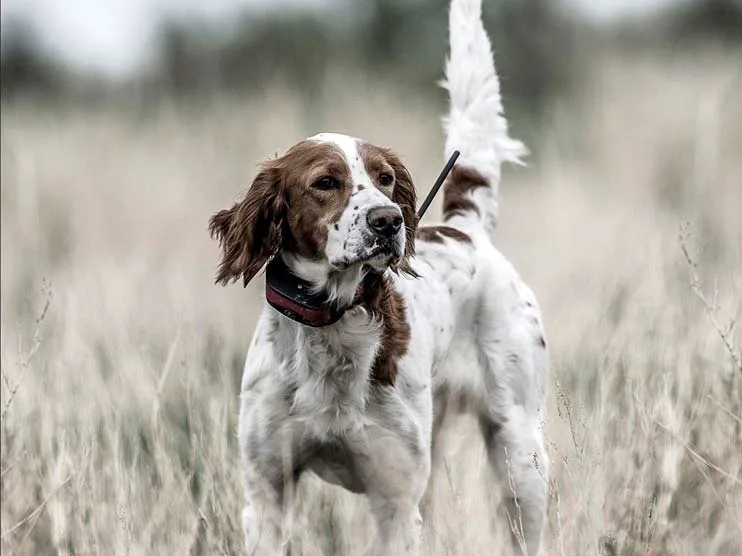
When training pointers, Josh Miller isn’t opposed to using e-collars. He just uses them after all fundamental work has been done. Josh Miller
Here’s a joke: What’s the only thing two dog trainers can agree on? The third trainer’s bad methods…when he’s not around. Funny ,because it’s true. The fact is, handlers favor their own methods. Depending on the dog, the training method
, and the hunting or training situation, the use of e-collars and a shock collar for dogs can be a highly subjective decision.
Early electronic collar adapters purchased them from companies like Sensatronics, that made receivers the size of milk containers that weighed just under a pound. The “Superheterodyne Electronic Dog Trainer” hit the shelves in 1962. Since then, e-collars
have come a long way. They’re smaller and lighter, and feature things like vibrations, sounds, and GPS tracking
. But dog owners remain split on whether to use a shock collar for dogs or not. Some handlers swear by them, while others wouldn’t take a case of e-collars for free.
Despite significant improvements in e-collar technology, many countries would like to see them disappear. A recent claim from the Dog’s Trust
, the largest dog welfare charity in the UK, stated that research proved electronic dog collars delivered bursts of electricity up to 6,000 volts for 11 seconds at a time. Although the voltage was exaggerated (the cited shock of 6,000 volts is actually only used in sheep and cattle fencing rather than dog e-collars), the UK along with several other European countries is putting laws into effect to ban e-collars.
Here in the U.S., e-collars are still available, and we have a choice between e-collars and the positive method for our dogs. To help in your decision, here are what some hunting and dog training professionals from both sides of the aisle have to say about the use of a shock collar for dogs.
Why Positive Training Delivers a Clearer Message Than a Shock Collar
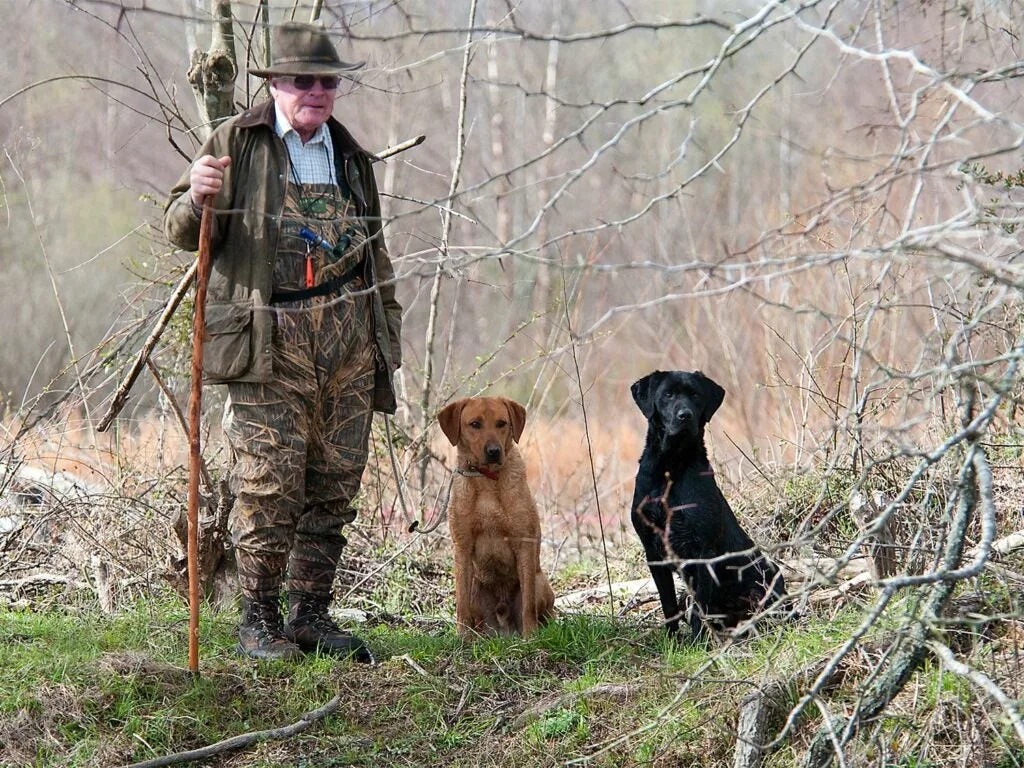
Robert Milner is considered to have introduced the positive-training method to the United States. He works with check cords and leads to teach dogs what he wants them to do. Robert Milner
Robert Milner, the author of Retriever Training for the Duck Hunter
, Retriever Training-A Back to Basics Approach
, and Absolutely Positively Gun Dog Training
, has used both approaches throughout his long and distinguished career. “When I founded Wild Rose Kennel in 1972, I trained over 1,000 dogs with e-collars,” Milner says. “I used them until 1982. That was the year when I first went to the UK. Over there, I learned about their shooting practices, dog training methods, field trials, and ultimately made significant changes. I converted Wildrose to all UK breeding stock and then shifted to many of their positive training methods. The Brits favor more gentle methods than many of those used in the states.
“To my mind, e-collars work by avoiding the negative. Call it a nick, call it a stimulation, call it what you want; a shock is a shock, and it is unpleasant. The nick has two behavioral effects on a dog. The first is that the dog is punished for doing something wrong. The second is that the punishment is stopped when the dog corrects its behavior. That is known as a successful escape response. E-collars basically work by creating a condition in which the dog can escape.
“Positive training delivers a clear message of what a handler wants a dog to do and then encourages it to choose to do it. I learned the importance of positive training for gun dogs several years after I sold Wildrose Kennels, and it was through a program that had nothing to do with hunting. In the years following 9/11, I was contracted by the Memphis Fire Department to rebuild the disaster dog program for their FEMA Urban Search and Rescue Task Force. The job of each Task Force was to sniff out buried victims and then to report the location to the handler to begin a rescue. I bought young started Labrador gun dogs
and placed them with new handlers and commenced training. After two to three months into the project, I measured our progress and projected that it was going to take 18 months to get the team operational. A year and a half was far too long, and that’s when I discovered positive training which begins with the use of clickers. I learned it, and taught it to the dogs and handlers. By telling the dogs what we wanted them to do and then encouraging them to do it, we reduced the training time down to six months. That’s a 300-percent reduction in training time. What I learned is that positive training is three times easier for a novice trainer to learn, and that it’s much faster for the dog to achieve a given performance level. I gave away all my electric collars
and have used positive training methods ever since.”
An Alternative to Using a Shock Collar for Dogs? Genetics
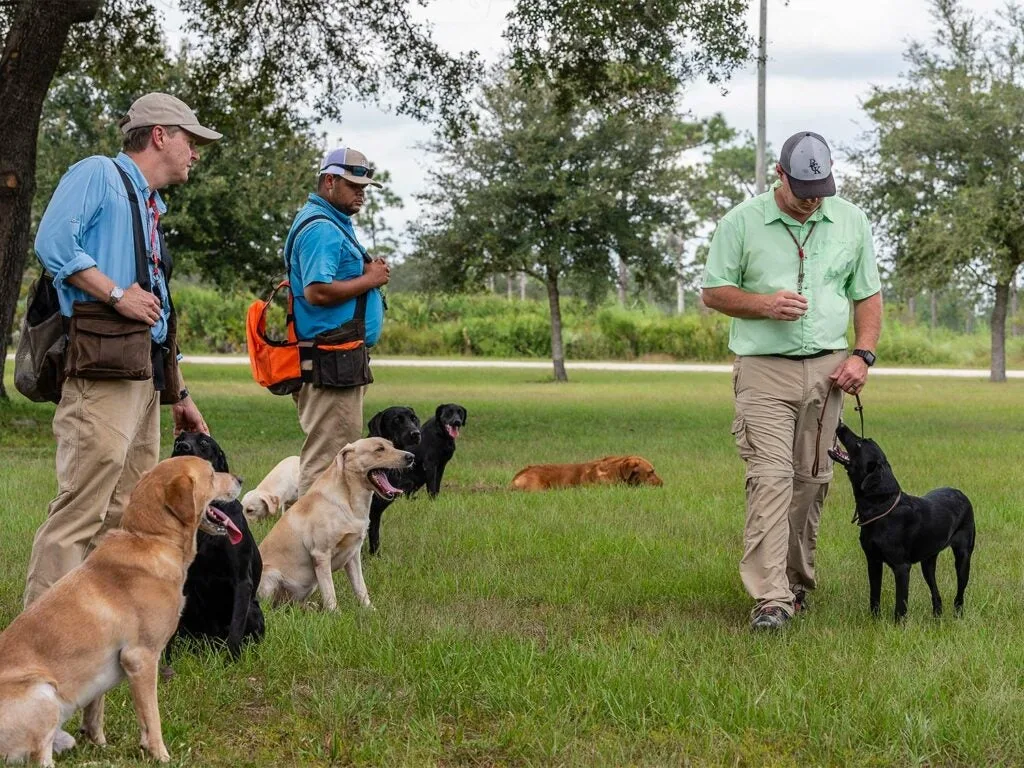
The Blue Cypress Kennels’ team (left to right) of Callum MacGregor, Noah Stapler, and Jeremy Criscoe focuses on genetics to breed dogs with drive and responsiveness. Once accomplished, they use positive-training methods for all of their dogs. Jeremy Criscoe
Jeremy Criscoe, a breeder, trainer, and handler with 30 HRCH and 15 Master Hunter titles says that if he has to use a shock collar for dogs, “I’ll give [them] away and get another dog with better genetics. Why should I have to train a dog to force fetch if I can breed one that naturally retrieves? Breeding takes more time and insight, but it’s a long-term solution that improves the breed.
“Collars change the natural way dogs work by temporarily fixing issues. Take an eye-strong dog that is marking dead birds. He’s not using his nose, right? Handlers then must use collars to control the dog’s behavior and to get him into the reeds to locate the bird. If that dog then wins a title, he’ll get bred, and the sight-marking characteristic is passed along. But if you breed a dog that uses his nose on marks, then you don’t need an e-collar.
“I’ve been a fan of positive training since I read Robert Milner’s first book. It’s a way to get a more natural response from a dog. I want dogs that will crash into the water
because they want to retrieve. I want their paws kicking up dirt when they get underway. Those characteristics come from careful, insightful breeding. Focus on the breeding, and you won’t need any training aids.”
How an Electronic Dog Collar Can Be a Valuable Training Tool

Josh Miller thinks of the e-collar as a very long check cord. Electronic collars reinforce training he has already completed. Josh Miller
Josh Miller is a pro trainer from Wisconsin and the winner of seven North American Shed Hunting Dog Association World Championship titles. He’s also the Product Training Specialist for SportDOG Brand. “I don’t know that one can say with 100-percent accuracy that one method is better than the other,” Miller says. “Both camps have passionate followers, but having a choice is the most important part of the question. Dogs, handlers, and situations vary significantly, and in my experience, there are times that call for a shock collar for dogs, and also times that do not. I train young dogs to be responsive without collars. When we’re ready for the next step, I’ll certainly use them for reinforcement at a distance as well as for finish work.”
Miller looks deeper at the issue and believes that the manner with which trainers use an e-collar is what sparks the debate. “When handlers properly use collars
, they are a tremendously beneficial training tool,” he says. “But the way some folks use them is opposite of the correct way. The electronic dog collar should be a long-range check cord or leash, something that motivates your dog to follow the command. Let’s say your dog is at a distance, and you call him to come, and he doesn’t pay attention. In most situations, the handler gives the command followed by a stimulation. The dog doesn’t know what is going on, gets scared, and runs for safety—which is to the handler. The collar gets the credit for having worked, but it’s really off base. The preferred way to use the collar begins with yard work and teaching the dog to obey the come command. So, when the dog is at a distance and the handler issues the come command and the dog doesn’t respond, the stim button is pressed and held at a low level. When the dog changes direction and heads back towards the handler, the button is released. Used that way, the dog clearly identifies that he’s being stimulated when he’s misbehaving and the shock disappears when he’s following the command. Properly using collars makes them a go-to training tool.
“The same holds true for shock collar placement, especially for staunching up dogs and keeping them from creeping. Place the electronic dog collar around the belly. That way the dog’s head remains high, and he doesn’t shake it when a stimulation is delivered. Breathing is improved as the windpipe is open, and less stimulation is needed because of the direct contact of the collar with the belly. When the e-collar is used properly, it serves its real purpose as an invisible leash when walking, as an invisible check cord when pointing, and as an overall tremendous training aid. But it should be used as a reinforcement of what has already been taught.”
How to Use an Shock Collar for Dogs on a Bird Hunt

Pennsylvania’s Thor Kain trains his dogs all year long for running in the cover dog field trial circuit. When he trains his dogs on wild birds, Kain straps e-collars on their belly. Deciding Point, call name Bek, is an example of how stylish his dogs look on point. Thor Kain
“A lot has changed over the years with regards to dog training,” says Thor Kain, whose dog Blast Zone is a former Cover Dog of the Year winner and the Mike Seminatore Award for the top, all-age English setter cover dog. But what is important to the topic at hand is that Kain won third place for Handler of the Year. “The old way of training included a spike collar, a check cord
, and a good beating. Good genetics in a dog results in easier training, and when it comes to e-collars, I think of them as a very long check cord. E-collars can be used for correction or to get a dog to pay attention. The only time I use my collars for correction is when they are chasing deer. Other than that, I work dogs with a check cord until they stand pigeons and are steady to wing and shot with a check cord. Then I’ll introduce them to an e-collar. I never ask a dog to do something with an e-collar that I wouldn’t ask them to do with a check cord. If you do, you’ll get a confused dog that does things out of fear.
“I run collars around a dog’s neck when I’m training, but when I put them on birds, I shift the position to their belly. When the collar is on their belly, the stim comes from an area that is far from their head. That’s important because as a field trialer, I don’t want the dog to have any association between the stim and the bird. I also want my dogs to make commitments, which is to either point or to knock the bird. If he knocks the bird, I can correct that behavior by standing him up. Handlers who stim dogs to stop them from creeping, train their dogs to make false points. The first order of business is that the dog points at first contact with scent. If the bird has moved and the dog is relocating to pin the bird and the handler stims him, then the dog will learn not to move. That’s where a lot of false points come from. I don’t use stim in that instance and would much rather the dog be bold and bust the bird. Then I know what correction is needed. When dogs chase flushed birds, hold down the stim button and roll the intensity knob until it is high enough for them to stop. The gradually increasing intensity teaches them what is coming the next time, and you’ll have staunch dogs very quickly. I use the collar to get the dog to listen to me. After I have his attention, the rest of our training with the check cord
kicks in.”
The Takeaway on the Shock Collar for Dog Owners
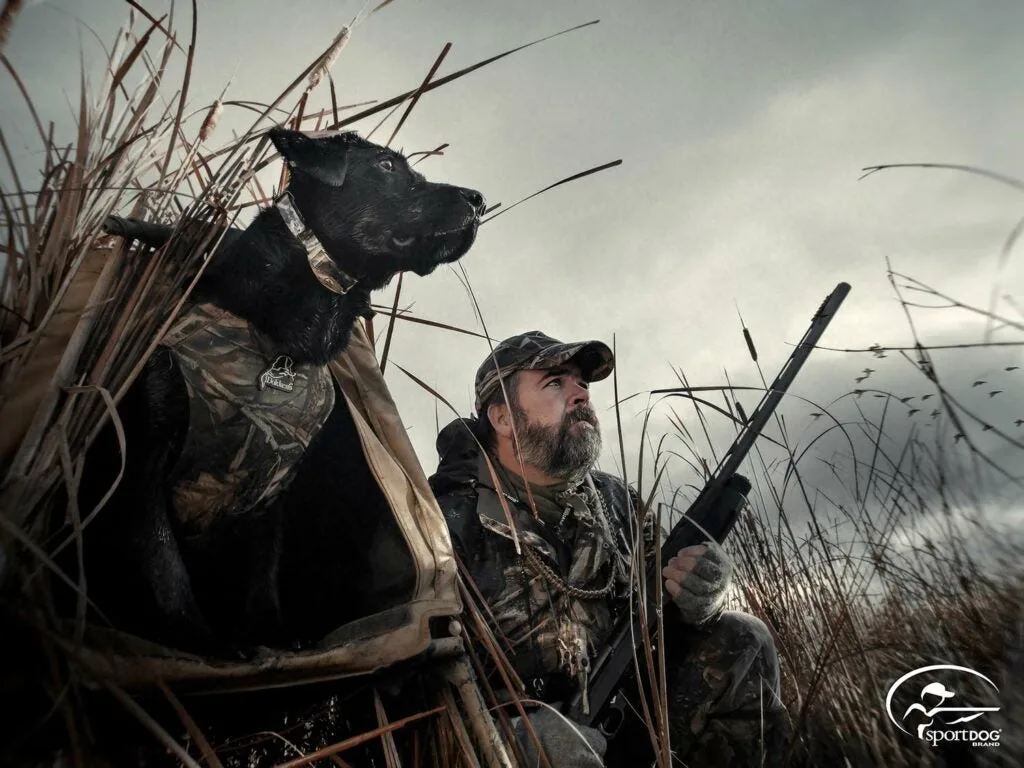
Oz takes his owner Darrel Douglas hunting. Douglas is SportDOG’s Associate Director and spends a lot of time researching customer wants, needs, and demands. Then he and his teams go to work developing prototypes. SportDOG Brand
In the end, to use e-collars or not to use e-collars really isn’t the question. Instead, the question is which training method
is best for you and your dog. For some, the positive method is the best way to handle your pup. For bigger running dogs
that need an occasional reminder of lessons learned, an e-collar provides some reinforcement. There is no right or wrong answer here, but how your dog handles makes all the difference in the world. And that’s a decision for every professional, amateur, and recreational handler and trainer to make as they see fit. If you do choose to use an e-collar here are some reliable options:
Hunting Gear: The Best E Collar for Dog Training
Garmin PRO 550 Dog Training System
In 2011, GPS-giant Garmin purchased Tri-Tronics, the e-collar specialty company, to form Garmin Tri-Tronics.
Dogtra 1900S Series
For over 30 years, Torrance, California’s Dogtra
has produced a wide variety of high-quality e-collars and other training gear.
SportDOG Brand 425X
Headquartered in Knoxville, TN, SportDOG Brand
is the sporting dog training gear company owned by Radio Systems Corporation.
D.T. Systems R.A.P.T. 1400
The Dallas, Texas-based D.T. Systems
has been manufacturing high-quality e-collars and dog training gear since 1983.

